Audit and Assurance Assignment: Elmo Software Audit Plan
VerifiedAdded on 2023/01/05
|13
|3047
|85
Report
AI Summary
This assignment provides a detailed audit plan for Elmo Software Limited, a company listed on the Australian Securities Exchange. Part A focuses on preliminary risk assessment, evaluating factors such as customer retention, key personnel, and over-reliance on software services. It also includes an analytical review of the company's financial performance, using financial statements to assess asset growth, liability changes, and cash flow. Furthermore, the assignment addresses audit planning materiality. Part B delves into the quality and effectiveness of independent audits in Australia, discussing key concerns and potential solutions. This includes conducting effective audit reviews, addressing audit concerns, and improving audit firm action plans to enhance audit quality. The report also addresses specific audit areas, such as intangible assets and trade payables.
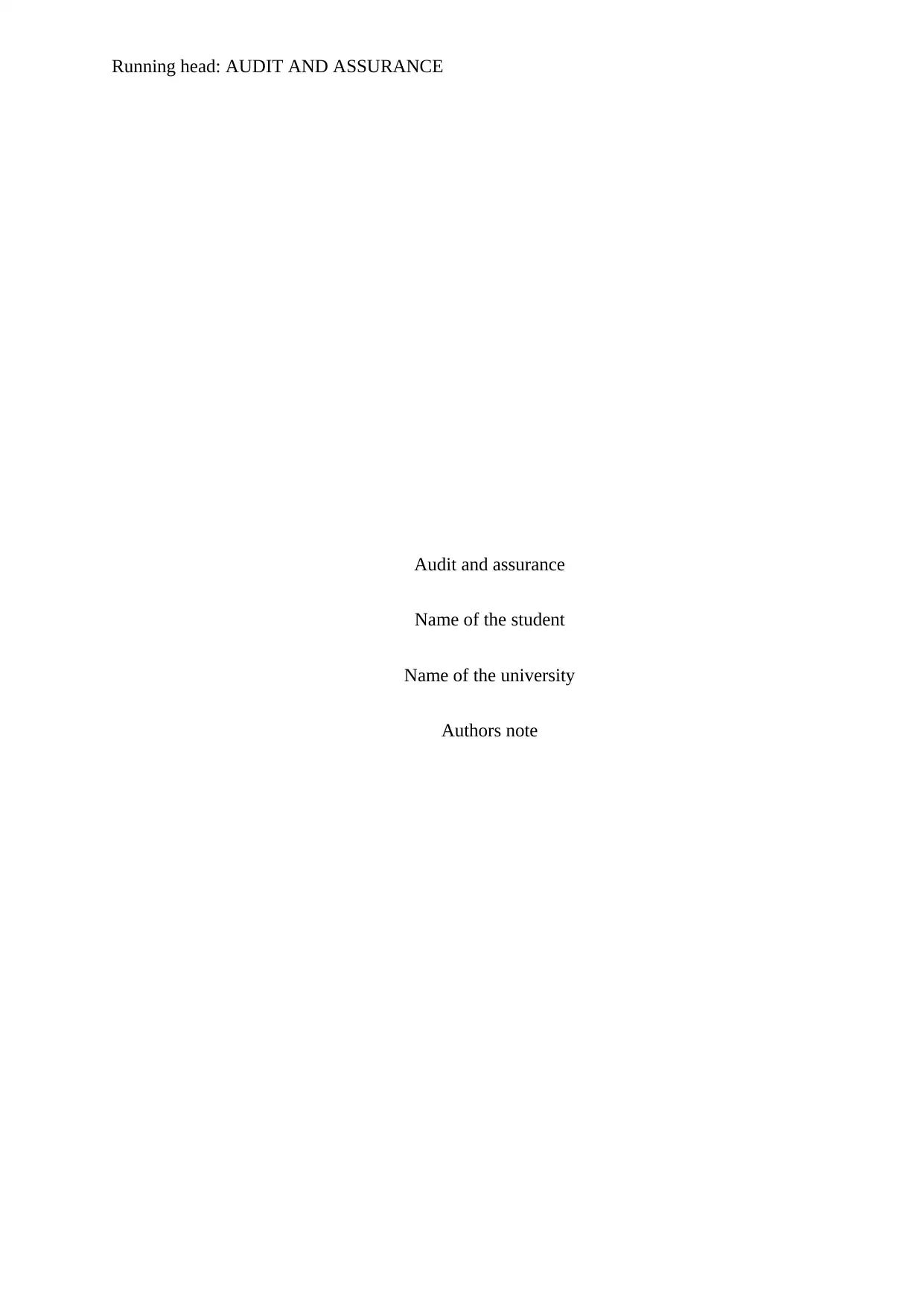
Running head: AUDIT AND ASSURANCE
Audit and assurance
Name of the student
Name of the university
Authors note
Audit and assurance
Name of the student
Name of the university
Authors note
Paraphrase This Document
Need a fresh take? Get an instant paraphrase of this document with our AI Paraphraser
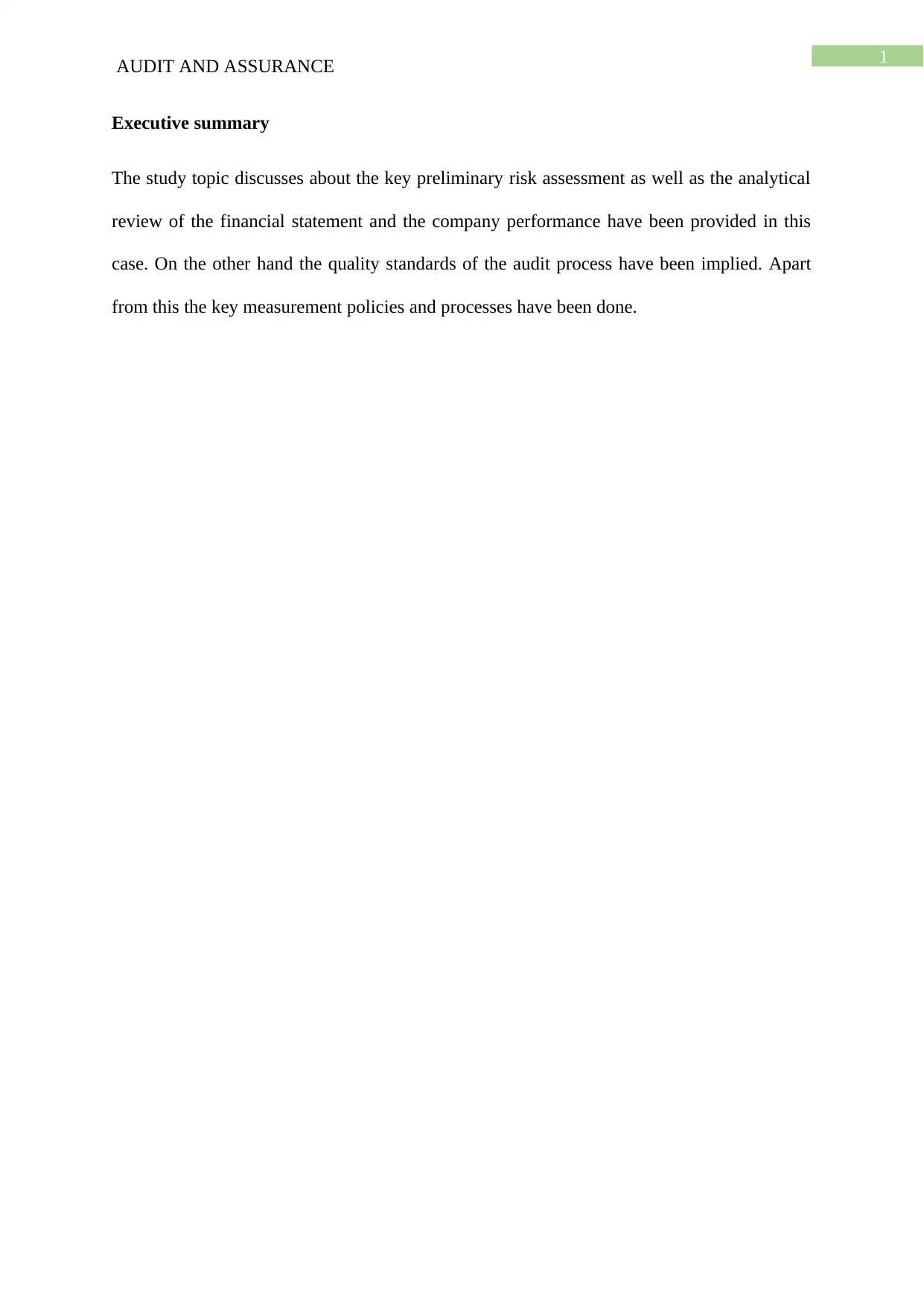
1
AUDIT AND ASSURANCE
Executive summary
The study topic discusses about the key preliminary risk assessment as well as the analytical
review of the financial statement and the company performance have been provided in this
case. On the other hand the quality standards of the audit process have been implied. Apart
from this the key measurement policies and processes have been done.
AUDIT AND ASSURANCE
Executive summary
The study topic discusses about the key preliminary risk assessment as well as the analytical
review of the financial statement and the company performance have been provided in this
case. On the other hand the quality standards of the audit process have been implied. Apart
from this the key measurement policies and processes have been done.
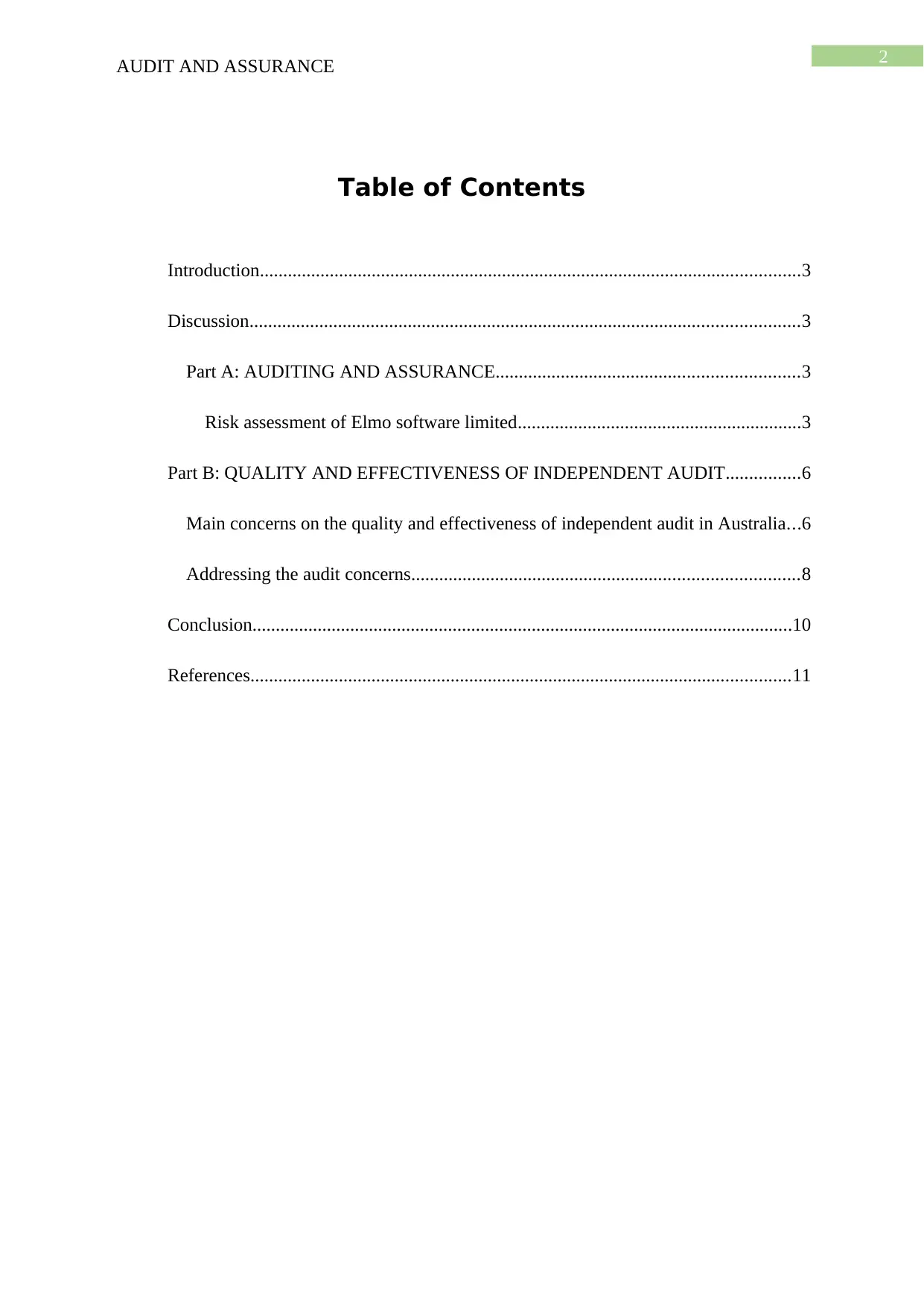
2
AUDIT AND ASSURANCE
Table of Contents
Introduction....................................................................................................................3
Discussion......................................................................................................................3
Part A: AUDITING AND ASSURANCE.................................................................3
Risk assessment of Elmo software limited.............................................................3
Part B: QUALITY AND EFFECTIVENESS OF INDEPENDENT AUDIT................6
Main concerns on the quality and effectiveness of independent audit in Australia...6
Addressing the audit concerns...................................................................................8
Conclusion....................................................................................................................10
References....................................................................................................................11
AUDIT AND ASSURANCE
Table of Contents
Introduction....................................................................................................................3
Discussion......................................................................................................................3
Part A: AUDITING AND ASSURANCE.................................................................3
Risk assessment of Elmo software limited.............................................................3
Part B: QUALITY AND EFFECTIVENESS OF INDEPENDENT AUDIT................6
Main concerns on the quality and effectiveness of independent audit in Australia...6
Addressing the audit concerns...................................................................................8
Conclusion....................................................................................................................10
References....................................................................................................................11
⊘ This is a preview!⊘
Do you want full access?
Subscribe today to unlock all pages.

Trusted by 1+ million students worldwide
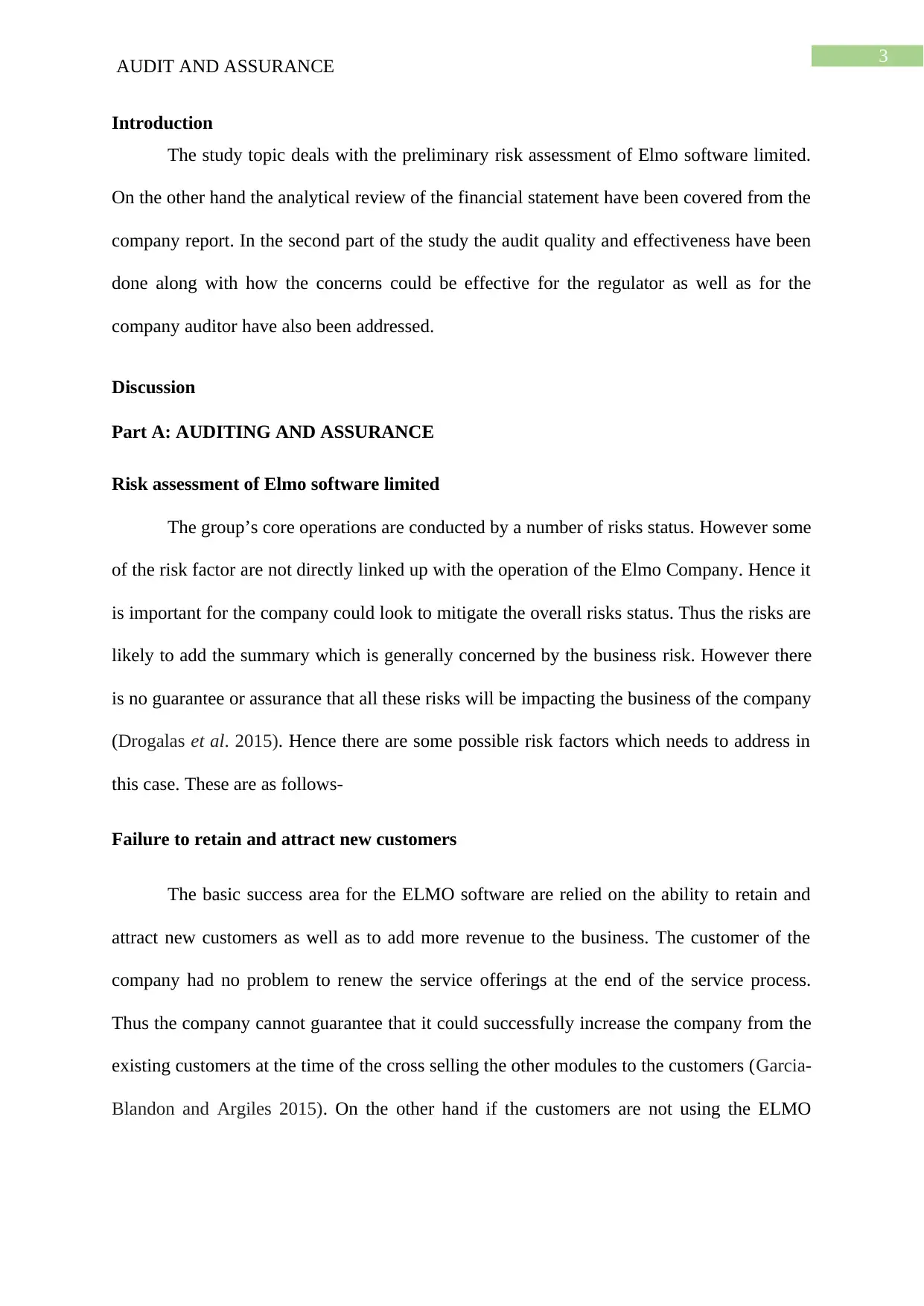
3
AUDIT AND ASSURANCE
Introduction
The study topic deals with the preliminary risk assessment of Elmo software limited.
On the other hand the analytical review of the financial statement have been covered from the
company report. In the second part of the study the audit quality and effectiveness have been
done along with how the concerns could be effective for the regulator as well as for the
company auditor have also been addressed.
Discussion
Part A: AUDITING AND ASSURANCE
Risk assessment of Elmo software limited
The group’s core operations are conducted by a number of risks status. However some
of the risk factor are not directly linked up with the operation of the Elmo Company. Hence it
is important for the company could look to mitigate the overall risks status. Thus the risks are
likely to add the summary which is generally concerned by the business risk. However there
is no guarantee or assurance that all these risks will be impacting the business of the company
(Drogalas et al. 2015). Hence there are some possible risk factors which needs to address in
this case. These are as follows-
Failure to retain and attract new customers
The basic success area for the ELMO software are relied on the ability to retain and
attract new customers as well as to add more revenue to the business. The customer of the
company had no problem to renew the service offerings at the end of the service process.
Thus the company cannot guarantee that it could successfully increase the company from the
existing customers at the time of the cross selling the other modules to the customers (Garcia-
Blandon and Argiles 2015). On the other hand if the customers are not using the ELMO
AUDIT AND ASSURANCE
Introduction
The study topic deals with the preliminary risk assessment of Elmo software limited.
On the other hand the analytical review of the financial statement have been covered from the
company report. In the second part of the study the audit quality and effectiveness have been
done along with how the concerns could be effective for the regulator as well as for the
company auditor have also been addressed.
Discussion
Part A: AUDITING AND ASSURANCE
Risk assessment of Elmo software limited
The group’s core operations are conducted by a number of risks status. However some
of the risk factor are not directly linked up with the operation of the Elmo Company. Hence it
is important for the company could look to mitigate the overall risks status. Thus the risks are
likely to add the summary which is generally concerned by the business risk. However there
is no guarantee or assurance that all these risks will be impacting the business of the company
(Drogalas et al. 2015). Hence there are some possible risk factors which needs to address in
this case. These are as follows-
Failure to retain and attract new customers
The basic success area for the ELMO software are relied on the ability to retain and
attract new customers as well as to add more revenue to the business. The customer of the
company had no problem to renew the service offerings at the end of the service process.
Thus the company cannot guarantee that it could successfully increase the company from the
existing customers at the time of the cross selling the other modules to the customers (Garcia-
Blandon and Argiles 2015). On the other hand if the customers are not using the ELMO
Paraphrase This Document
Need a fresh take? Get an instant paraphrase of this document with our AI Paraphraser
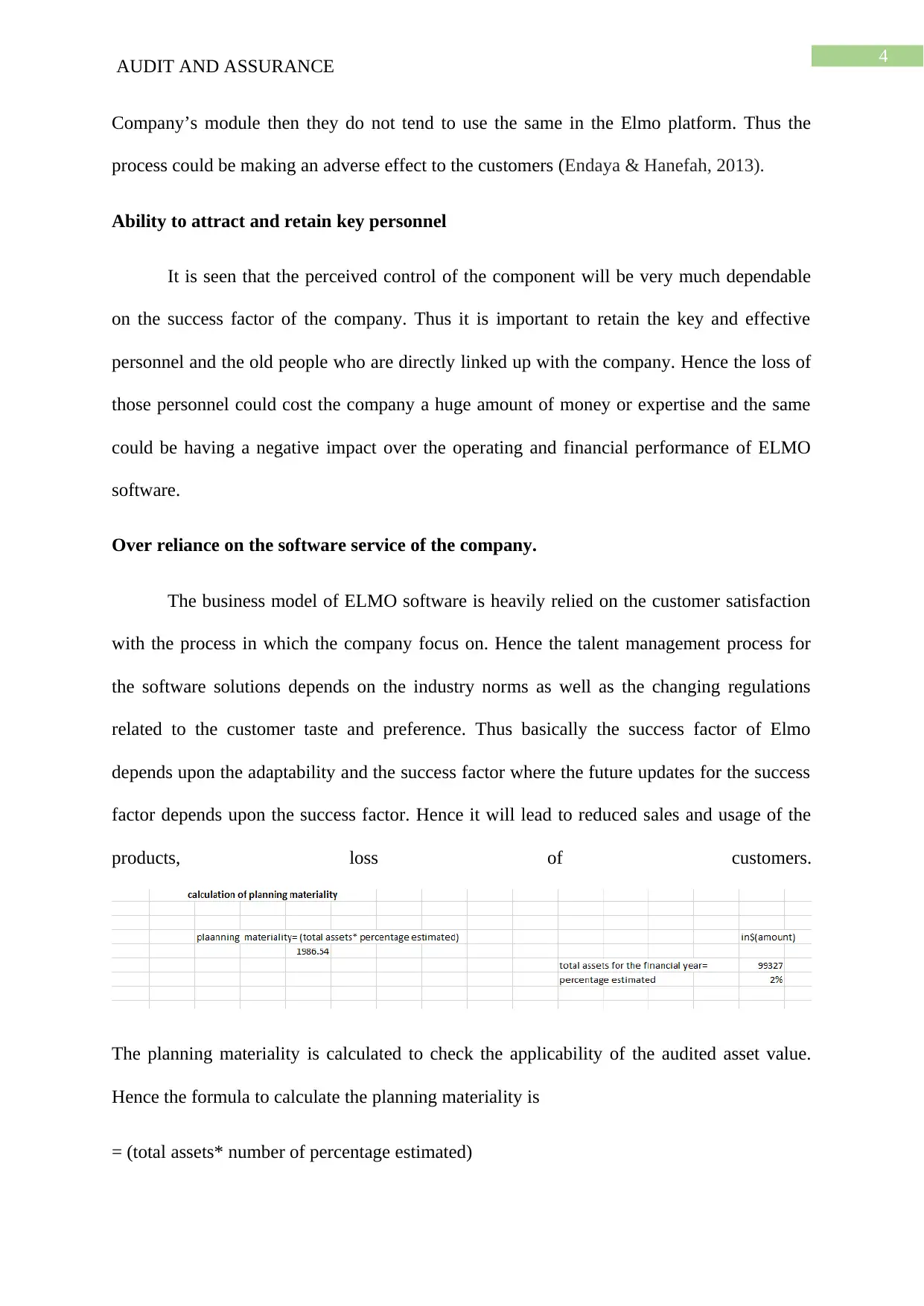
4
AUDIT AND ASSURANCE
Company’s module then they do not tend to use the same in the Elmo platform. Thus the
process could be making an adverse effect to the customers (Endaya & Hanefah, 2013).
Ability to attract and retain key personnel
It is seen that the perceived control of the component will be very much dependable
on the success factor of the company. Thus it is important to retain the key and effective
personnel and the old people who are directly linked up with the company. Hence the loss of
those personnel could cost the company a huge amount of money or expertise and the same
could be having a negative impact over the operating and financial performance of ELMO
software.
Over reliance on the software service of the company.
The business model of ELMO software is heavily relied on the customer satisfaction
with the process in which the company focus on. Hence the talent management process for
the software solutions depends on the industry norms as well as the changing regulations
related to the customer taste and preference. Thus basically the success factor of Elmo
depends upon the adaptability and the success factor where the future updates for the success
factor depends upon the success factor. Hence it will lead to reduced sales and usage of the
products, loss of customers.
The planning materiality is calculated to check the applicability of the audited asset value.
Hence the formula to calculate the planning materiality is
= (total assets* number of percentage estimated)
AUDIT AND ASSURANCE
Company’s module then they do not tend to use the same in the Elmo platform. Thus the
process could be making an adverse effect to the customers (Endaya & Hanefah, 2013).
Ability to attract and retain key personnel
It is seen that the perceived control of the component will be very much dependable
on the success factor of the company. Thus it is important to retain the key and effective
personnel and the old people who are directly linked up with the company. Hence the loss of
those personnel could cost the company a huge amount of money or expertise and the same
could be having a negative impact over the operating and financial performance of ELMO
software.
Over reliance on the software service of the company.
The business model of ELMO software is heavily relied on the customer satisfaction
with the process in which the company focus on. Hence the talent management process for
the software solutions depends on the industry norms as well as the changing regulations
related to the customer taste and preference. Thus basically the success factor of Elmo
depends upon the adaptability and the success factor where the future updates for the success
factor depends upon the success factor. Hence it will lead to reduced sales and usage of the
products, loss of customers.
The planning materiality is calculated to check the applicability of the audited asset value.
Hence the formula to calculate the planning materiality is
= (total assets* number of percentage estimated)
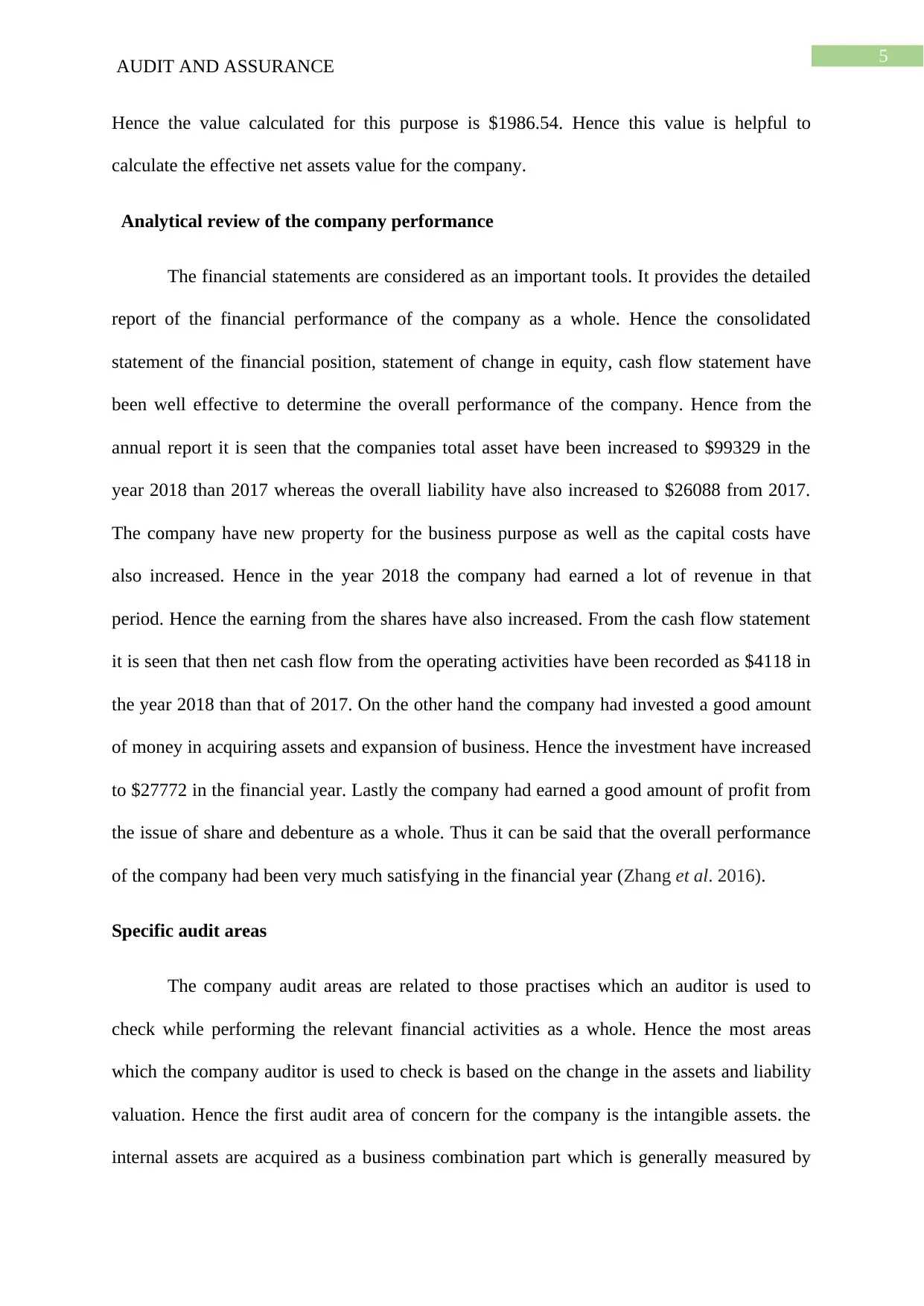
5
AUDIT AND ASSURANCE
Hence the value calculated for this purpose is $1986.54. Hence this value is helpful to
calculate the effective net assets value for the company.
Analytical review of the company performance
The financial statements are considered as an important tools. It provides the detailed
report of the financial performance of the company as a whole. Hence the consolidated
statement of the financial position, statement of change in equity, cash flow statement have
been well effective to determine the overall performance of the company. Hence from the
annual report it is seen that the companies total asset have been increased to $99329 in the
year 2018 than 2017 whereas the overall liability have also increased to $26088 from 2017.
The company have new property for the business purpose as well as the capital costs have
also increased. Hence in the year 2018 the company had earned a lot of revenue in that
period. Hence the earning from the shares have also increased. From the cash flow statement
it is seen that then net cash flow from the operating activities have been recorded as $4118 in
the year 2018 than that of 2017. On the other hand the company had invested a good amount
of money in acquiring assets and expansion of business. Hence the investment have increased
to $27772 in the financial year. Lastly the company had earned a good amount of profit from
the issue of share and debenture as a whole. Thus it can be said that the overall performance
of the company had been very much satisfying in the financial year (Zhang et al. 2016).
Specific audit areas
The company audit areas are related to those practises which an auditor is used to
check while performing the relevant financial activities as a whole. Hence the most areas
which the company auditor is used to check is based on the change in the assets and liability
valuation. Hence the first audit area of concern for the company is the intangible assets. the
internal assets are acquired as a business combination part which is generally measured by
AUDIT AND ASSURANCE
Hence the value calculated for this purpose is $1986.54. Hence this value is helpful to
calculate the effective net assets value for the company.
Analytical review of the company performance
The financial statements are considered as an important tools. It provides the detailed
report of the financial performance of the company as a whole. Hence the consolidated
statement of the financial position, statement of change in equity, cash flow statement have
been well effective to determine the overall performance of the company. Hence from the
annual report it is seen that the companies total asset have been increased to $99329 in the
year 2018 than 2017 whereas the overall liability have also increased to $26088 from 2017.
The company have new property for the business purpose as well as the capital costs have
also increased. Hence in the year 2018 the company had earned a lot of revenue in that
period. Hence the earning from the shares have also increased. From the cash flow statement
it is seen that then net cash flow from the operating activities have been recorded as $4118 in
the year 2018 than that of 2017. On the other hand the company had invested a good amount
of money in acquiring assets and expansion of business. Hence the investment have increased
to $27772 in the financial year. Lastly the company had earned a good amount of profit from
the issue of share and debenture as a whole. Thus it can be said that the overall performance
of the company had been very much satisfying in the financial year (Zhang et al. 2016).
Specific audit areas
The company audit areas are related to those practises which an auditor is used to
check while performing the relevant financial activities as a whole. Hence the most areas
which the company auditor is used to check is based on the change in the assets and liability
valuation. Hence the first audit area of concern for the company is the intangible assets. the
internal assets are acquired as a business combination part which is generally measured by
⊘ This is a preview!⊘
Do you want full access?
Subscribe today to unlock all pages.

Trusted by 1+ million students worldwide
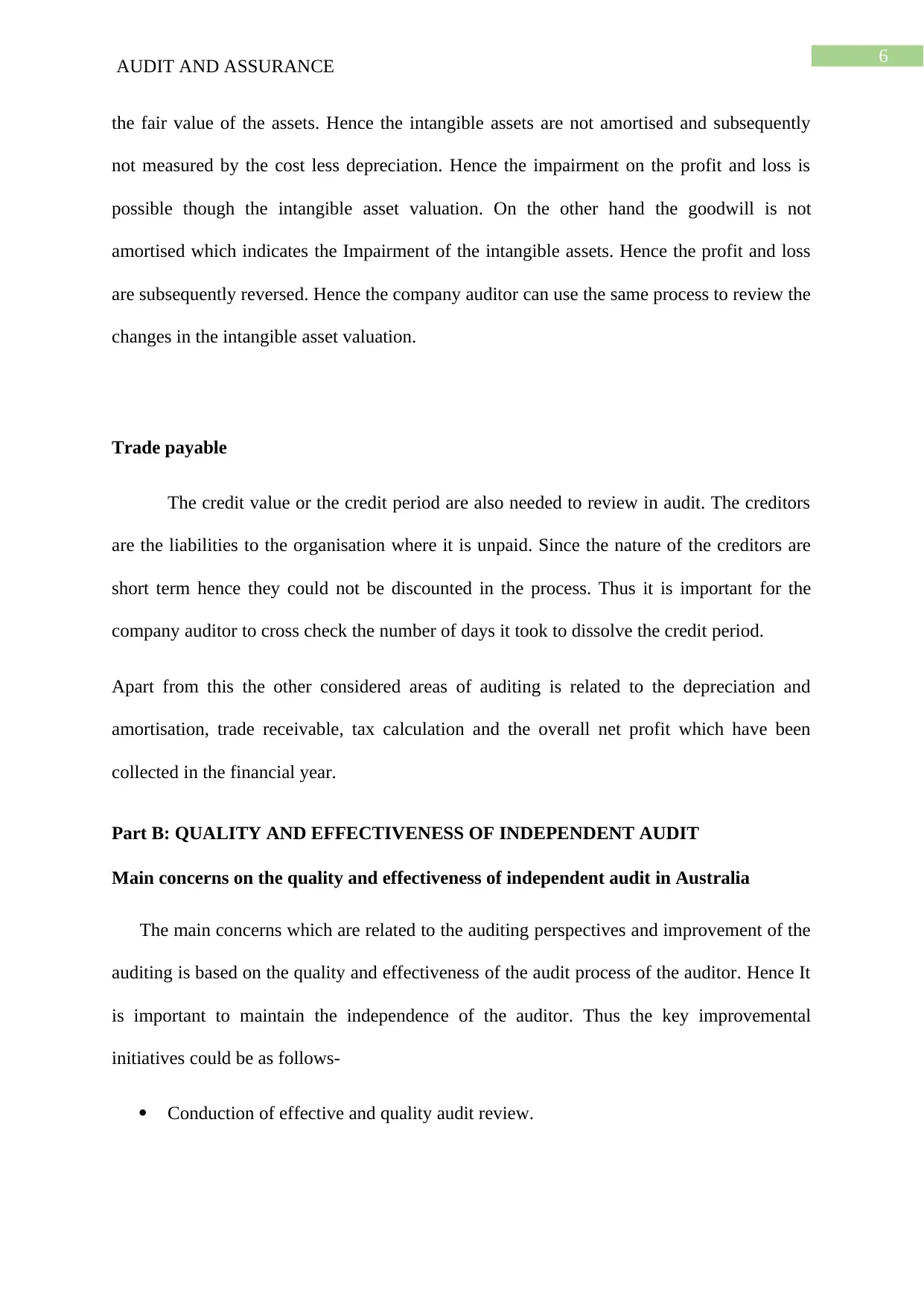
6
AUDIT AND ASSURANCE
the fair value of the assets. Hence the intangible assets are not amortised and subsequently
not measured by the cost less depreciation. Hence the impairment on the profit and loss is
possible though the intangible asset valuation. On the other hand the goodwill is not
amortised which indicates the Impairment of the intangible assets. Hence the profit and loss
are subsequently reversed. Hence the company auditor can use the same process to review the
changes in the intangible asset valuation.
Trade payable
The credit value or the credit period are also needed to review in audit. The creditors
are the liabilities to the organisation where it is unpaid. Since the nature of the creditors are
short term hence they could not be discounted in the process. Thus it is important for the
company auditor to cross check the number of days it took to dissolve the credit period.
Apart from this the other considered areas of auditing is related to the depreciation and
amortisation, trade receivable, tax calculation and the overall net profit which have been
collected in the financial year.
Part B: QUALITY AND EFFECTIVENESS OF INDEPENDENT AUDIT
Main concerns on the quality and effectiveness of independent audit in Australia
The main concerns which are related to the auditing perspectives and improvement of the
auditing is based on the quality and effectiveness of the audit process of the auditor. Hence It
is important to maintain the independence of the auditor. Thus the key improvemental
initiatives could be as follows-
Conduction of effective and quality audit review.
AUDIT AND ASSURANCE
the fair value of the assets. Hence the intangible assets are not amortised and subsequently
not measured by the cost less depreciation. Hence the impairment on the profit and loss is
possible though the intangible asset valuation. On the other hand the goodwill is not
amortised which indicates the Impairment of the intangible assets. Hence the profit and loss
are subsequently reversed. Hence the company auditor can use the same process to review the
changes in the intangible asset valuation.
Trade payable
The credit value or the credit period are also needed to review in audit. The creditors
are the liabilities to the organisation where it is unpaid. Since the nature of the creditors are
short term hence they could not be discounted in the process. Thus it is important for the
company auditor to cross check the number of days it took to dissolve the credit period.
Apart from this the other considered areas of auditing is related to the depreciation and
amortisation, trade receivable, tax calculation and the overall net profit which have been
collected in the financial year.
Part B: QUALITY AND EFFECTIVENESS OF INDEPENDENT AUDIT
Main concerns on the quality and effectiveness of independent audit in Australia
The main concerns which are related to the auditing perspectives and improvement of the
auditing is based on the quality and effectiveness of the audit process of the auditor. Hence It
is important to maintain the independence of the auditor. Thus the key improvemental
initiatives could be as follows-
Conduction of effective and quality audit review.
Paraphrase This Document
Need a fresh take? Get an instant paraphrase of this document with our AI Paraphraser
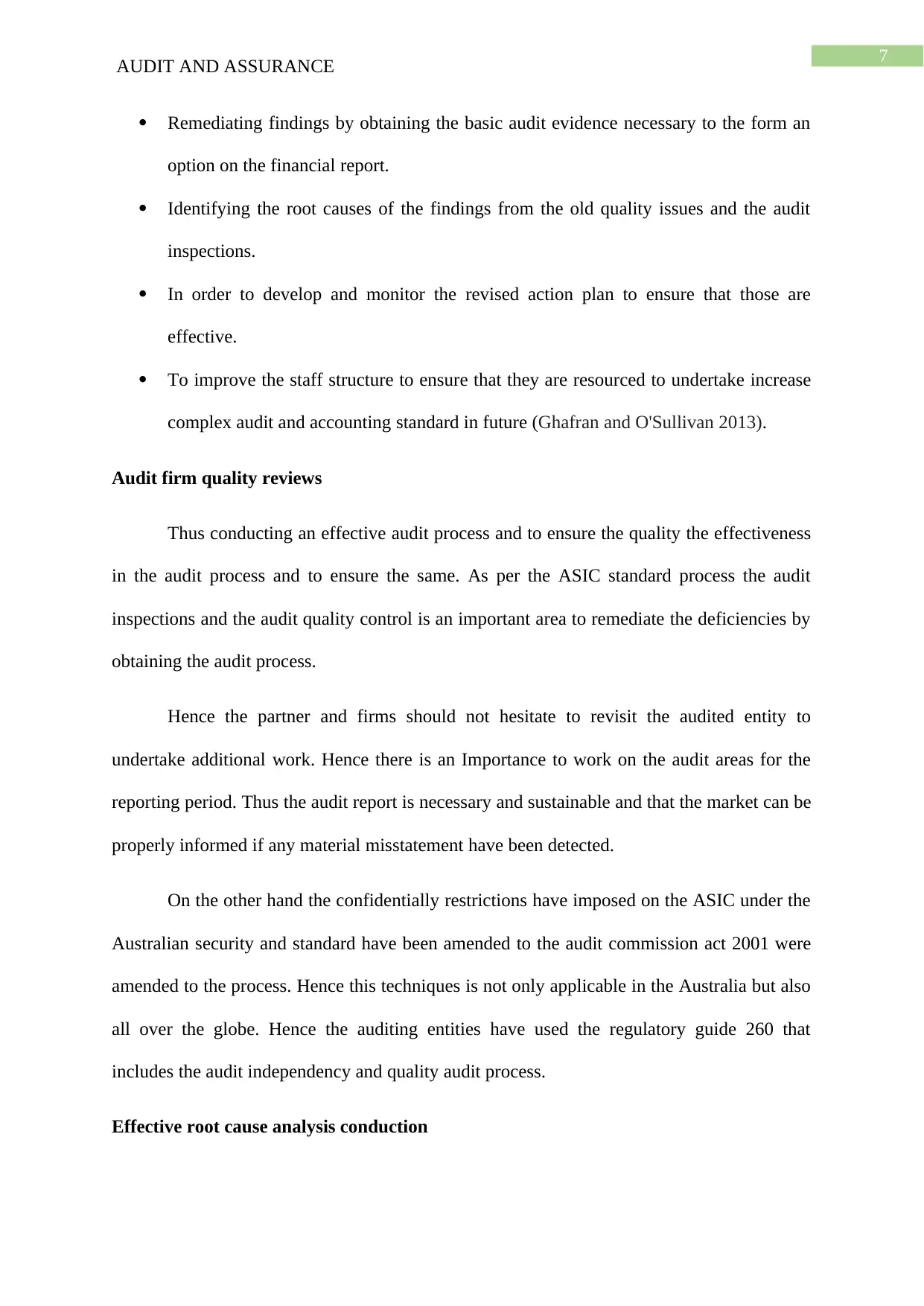
7
AUDIT AND ASSURANCE
Remediating findings by obtaining the basic audit evidence necessary to the form an
option on the financial report.
Identifying the root causes of the findings from the old quality issues and the audit
inspections.
In order to develop and monitor the revised action plan to ensure that those are
effective.
To improve the staff structure to ensure that they are resourced to undertake increase
complex audit and accounting standard in future (Ghafran and O'Sullivan 2013).
Audit firm quality reviews
Thus conducting an effective audit process and to ensure the quality the effectiveness
in the audit process and to ensure the same. As per the ASIC standard process the audit
inspections and the audit quality control is an important area to remediate the deficiencies by
obtaining the audit process.
Hence the partner and firms should not hesitate to revisit the audited entity to
undertake additional work. Hence there is an Importance to work on the audit areas for the
reporting period. Thus the audit report is necessary and sustainable and that the market can be
properly informed if any material misstatement have been detected.
On the other hand the confidentially restrictions have imposed on the ASIC under the
Australian security and standard have been amended to the audit commission act 2001 were
amended to the process. Hence this techniques is not only applicable in the Australia but also
all over the globe. Hence the auditing entities have used the regulatory guide 260 that
includes the audit independency and quality audit process.
Effective root cause analysis conduction
AUDIT AND ASSURANCE
Remediating findings by obtaining the basic audit evidence necessary to the form an
option on the financial report.
Identifying the root causes of the findings from the old quality issues and the audit
inspections.
In order to develop and monitor the revised action plan to ensure that those are
effective.
To improve the staff structure to ensure that they are resourced to undertake increase
complex audit and accounting standard in future (Ghafran and O'Sullivan 2013).
Audit firm quality reviews
Thus conducting an effective audit process and to ensure the quality the effectiveness
in the audit process and to ensure the same. As per the ASIC standard process the audit
inspections and the audit quality control is an important area to remediate the deficiencies by
obtaining the audit process.
Hence the partner and firms should not hesitate to revisit the audited entity to
undertake additional work. Hence there is an Importance to work on the audit areas for the
reporting period. Thus the audit report is necessary and sustainable and that the market can be
properly informed if any material misstatement have been detected.
On the other hand the confidentially restrictions have imposed on the ASIC under the
Australian security and standard have been amended to the audit commission act 2001 were
amended to the process. Hence this techniques is not only applicable in the Australia but also
all over the globe. Hence the auditing entities have used the regulatory guide 260 that
includes the audit independency and quality audit process.
Effective root cause analysis conduction
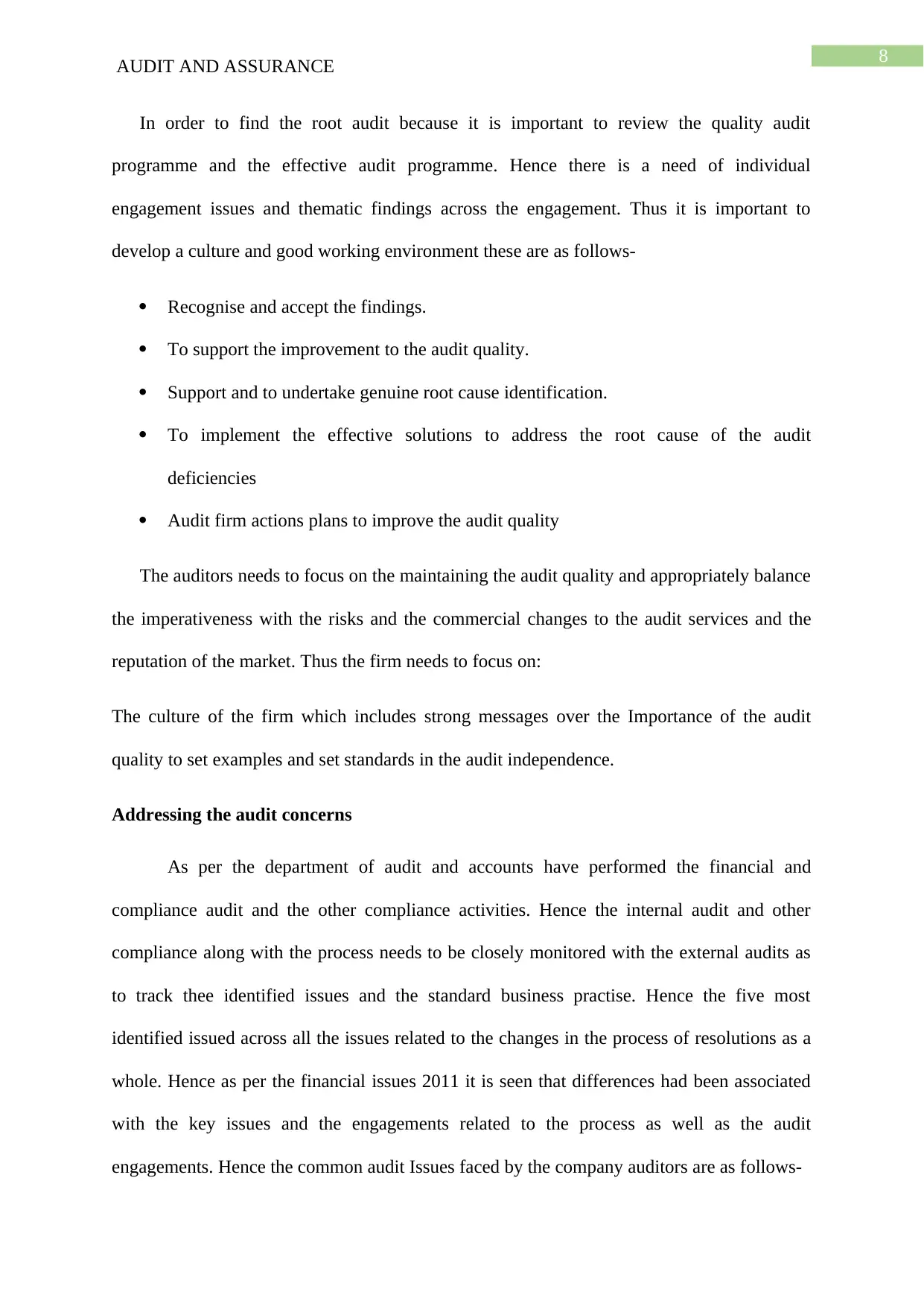
8
AUDIT AND ASSURANCE
In order to find the root audit because it is important to review the quality audit
programme and the effective audit programme. Hence there is a need of individual
engagement issues and thematic findings across the engagement. Thus it is important to
develop a culture and good working environment these are as follows-
Recognise and accept the findings.
To support the improvement to the audit quality.
Support and to undertake genuine root cause identification.
To implement the effective solutions to address the root cause of the audit
deficiencies
Audit firm actions plans to improve the audit quality
The auditors needs to focus on the maintaining the audit quality and appropriately balance
the imperativeness with the risks and the commercial changes to the audit services and the
reputation of the market. Thus the firm needs to focus on:
The culture of the firm which includes strong messages over the Importance of the audit
quality to set examples and set standards in the audit independence.
Addressing the audit concerns
As per the department of audit and accounts have performed the financial and
compliance audit and the other compliance activities. Hence the internal audit and other
compliance along with the process needs to be closely monitored with the external audits as
to track thee identified issues and the standard business practise. Hence the five most
identified issued across all the issues related to the changes in the process of resolutions as a
whole. Hence as per the financial issues 2011 it is seen that differences had been associated
with the key issues and the engagements related to the process as well as the audit
engagements. Hence the common audit Issues faced by the company auditors are as follows-
AUDIT AND ASSURANCE
In order to find the root audit because it is important to review the quality audit
programme and the effective audit programme. Hence there is a need of individual
engagement issues and thematic findings across the engagement. Thus it is important to
develop a culture and good working environment these are as follows-
Recognise and accept the findings.
To support the improvement to the audit quality.
Support and to undertake genuine root cause identification.
To implement the effective solutions to address the root cause of the audit
deficiencies
Audit firm actions plans to improve the audit quality
The auditors needs to focus on the maintaining the audit quality and appropriately balance
the imperativeness with the risks and the commercial changes to the audit services and the
reputation of the market. Thus the firm needs to focus on:
The culture of the firm which includes strong messages over the Importance of the audit
quality to set examples and set standards in the audit independence.
Addressing the audit concerns
As per the department of audit and accounts have performed the financial and
compliance audit and the other compliance activities. Hence the internal audit and other
compliance along with the process needs to be closely monitored with the external audits as
to track thee identified issues and the standard business practise. Hence the five most
identified issued across all the issues related to the changes in the process of resolutions as a
whole. Hence as per the financial issues 2011 it is seen that differences had been associated
with the key issues and the engagements related to the process as well as the audit
engagements. Hence the common audit Issues faced by the company auditors are as follows-
⊘ This is a preview!⊘
Do you want full access?
Subscribe today to unlock all pages.

Trusted by 1+ million students worldwide
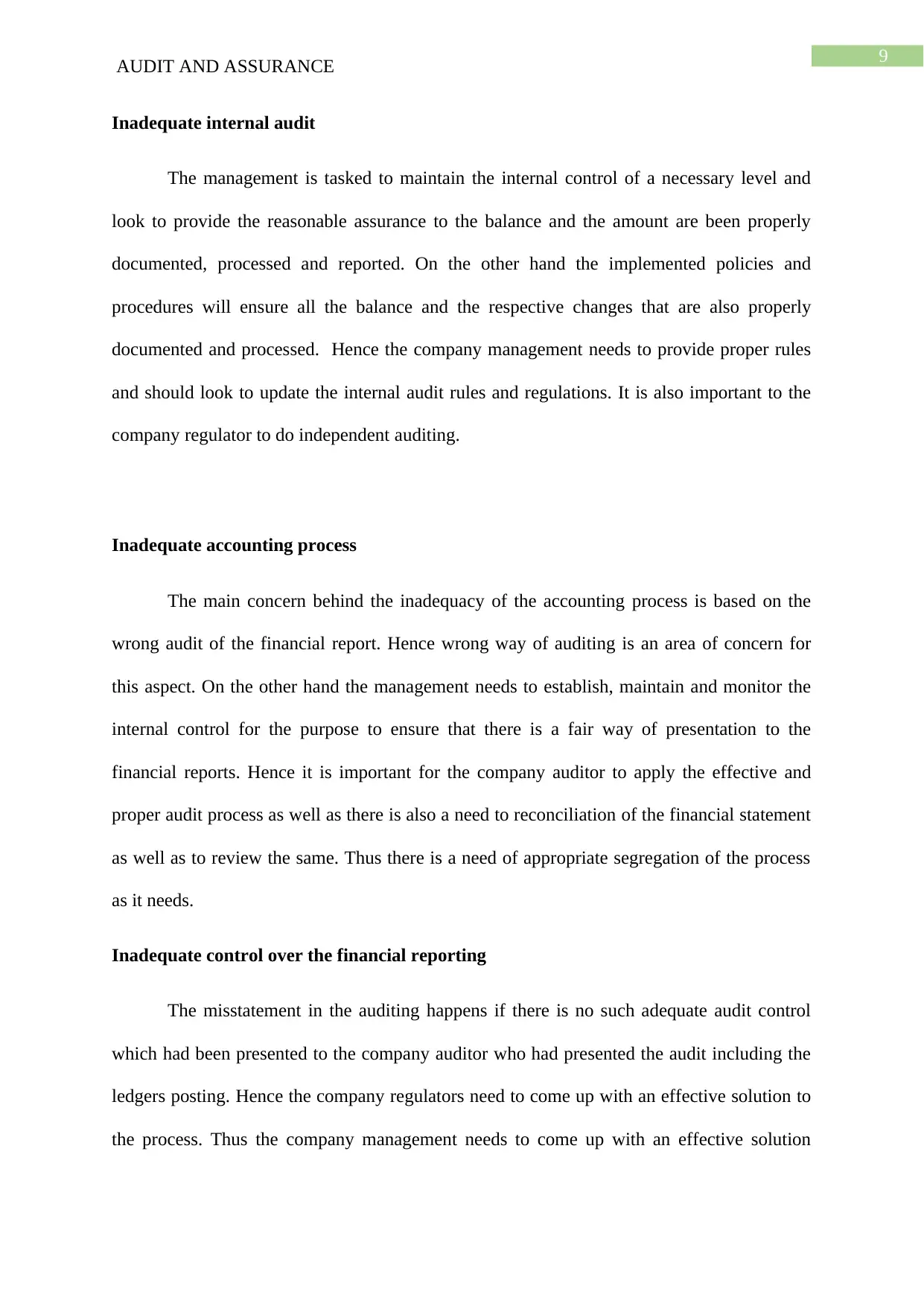
9
AUDIT AND ASSURANCE
Inadequate internal audit
The management is tasked to maintain the internal control of a necessary level and
look to provide the reasonable assurance to the balance and the amount are been properly
documented, processed and reported. On the other hand the implemented policies and
procedures will ensure all the balance and the respective changes that are also properly
documented and processed. Hence the company management needs to provide proper rules
and should look to update the internal audit rules and regulations. It is also important to the
company regulator to do independent auditing.
Inadequate accounting process
The main concern behind the inadequacy of the accounting process is based on the
wrong audit of the financial report. Hence wrong way of auditing is an area of concern for
this aspect. On the other hand the management needs to establish, maintain and monitor the
internal control for the purpose to ensure that there is a fair way of presentation to the
financial reports. Hence it is important for the company auditor to apply the effective and
proper audit process as well as there is also a need to reconciliation of the financial statement
as well as to review the same. Thus there is a need of appropriate segregation of the process
as it needs.
Inadequate control over the financial reporting
The misstatement in the auditing happens if there is no such adequate audit control
which had been presented to the company auditor who had presented the audit including the
ledgers posting. Hence the company regulators need to come up with an effective solution to
the process. Thus the company management needs to come up with an effective solution
AUDIT AND ASSURANCE
Inadequate internal audit
The management is tasked to maintain the internal control of a necessary level and
look to provide the reasonable assurance to the balance and the amount are been properly
documented, processed and reported. On the other hand the implemented policies and
procedures will ensure all the balance and the respective changes that are also properly
documented and processed. Hence the company management needs to provide proper rules
and should look to update the internal audit rules and regulations. It is also important to the
company regulator to do independent auditing.
Inadequate accounting process
The main concern behind the inadequacy of the accounting process is based on the
wrong audit of the financial report. Hence wrong way of auditing is an area of concern for
this aspect. On the other hand the management needs to establish, maintain and monitor the
internal control for the purpose to ensure that there is a fair way of presentation to the
financial reports. Hence it is important for the company auditor to apply the effective and
proper audit process as well as there is also a need to reconciliation of the financial statement
as well as to review the same. Thus there is a need of appropriate segregation of the process
as it needs.
Inadequate control over the financial reporting
The misstatement in the auditing happens if there is no such adequate audit control
which had been presented to the company auditor who had presented the audit including the
ledgers posting. Hence the company regulators need to come up with an effective solution to
the process. Thus the company management needs to come up with an effective solution
Paraphrase This Document
Need a fresh take? Get an instant paraphrase of this document with our AI Paraphraser
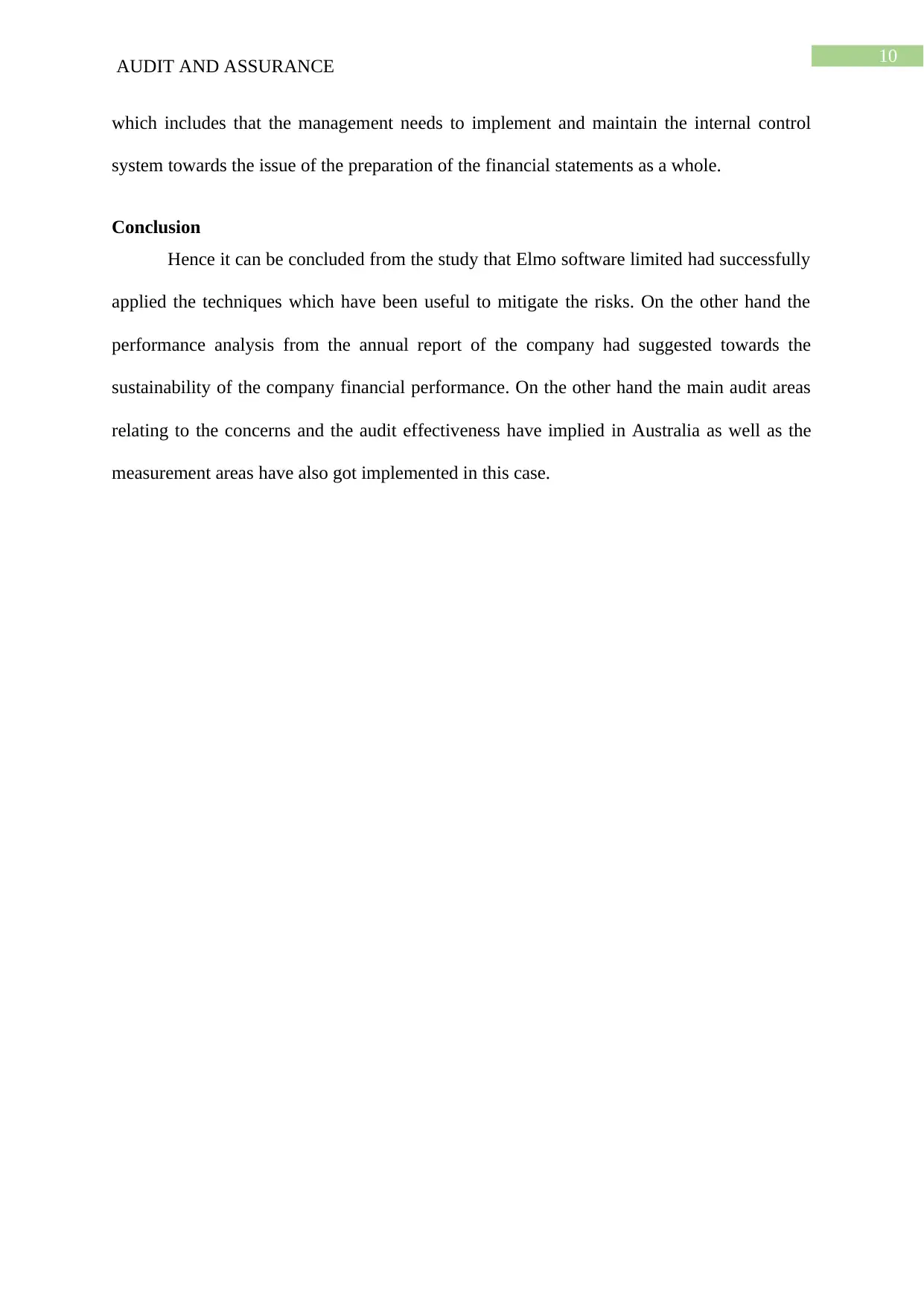
10
AUDIT AND ASSURANCE
which includes that the management needs to implement and maintain the internal control
system towards the issue of the preparation of the financial statements as a whole.
Conclusion
Hence it can be concluded from the study that Elmo software limited had successfully
applied the techniques which have been useful to mitigate the risks. On the other hand the
performance analysis from the annual report of the company had suggested towards the
sustainability of the company financial performance. On the other hand the main audit areas
relating to the concerns and the audit effectiveness have implied in Australia as well as the
measurement areas have also got implemented in this case.
AUDIT AND ASSURANCE
which includes that the management needs to implement and maintain the internal control
system towards the issue of the preparation of the financial statements as a whole.
Conclusion
Hence it can be concluded from the study that Elmo software limited had successfully
applied the techniques which have been useful to mitigate the risks. On the other hand the
performance analysis from the annual report of the company had suggested towards the
sustainability of the company financial performance. On the other hand the main audit areas
relating to the concerns and the audit effectiveness have implied in Australia as well as the
measurement areas have also got implemented in this case.
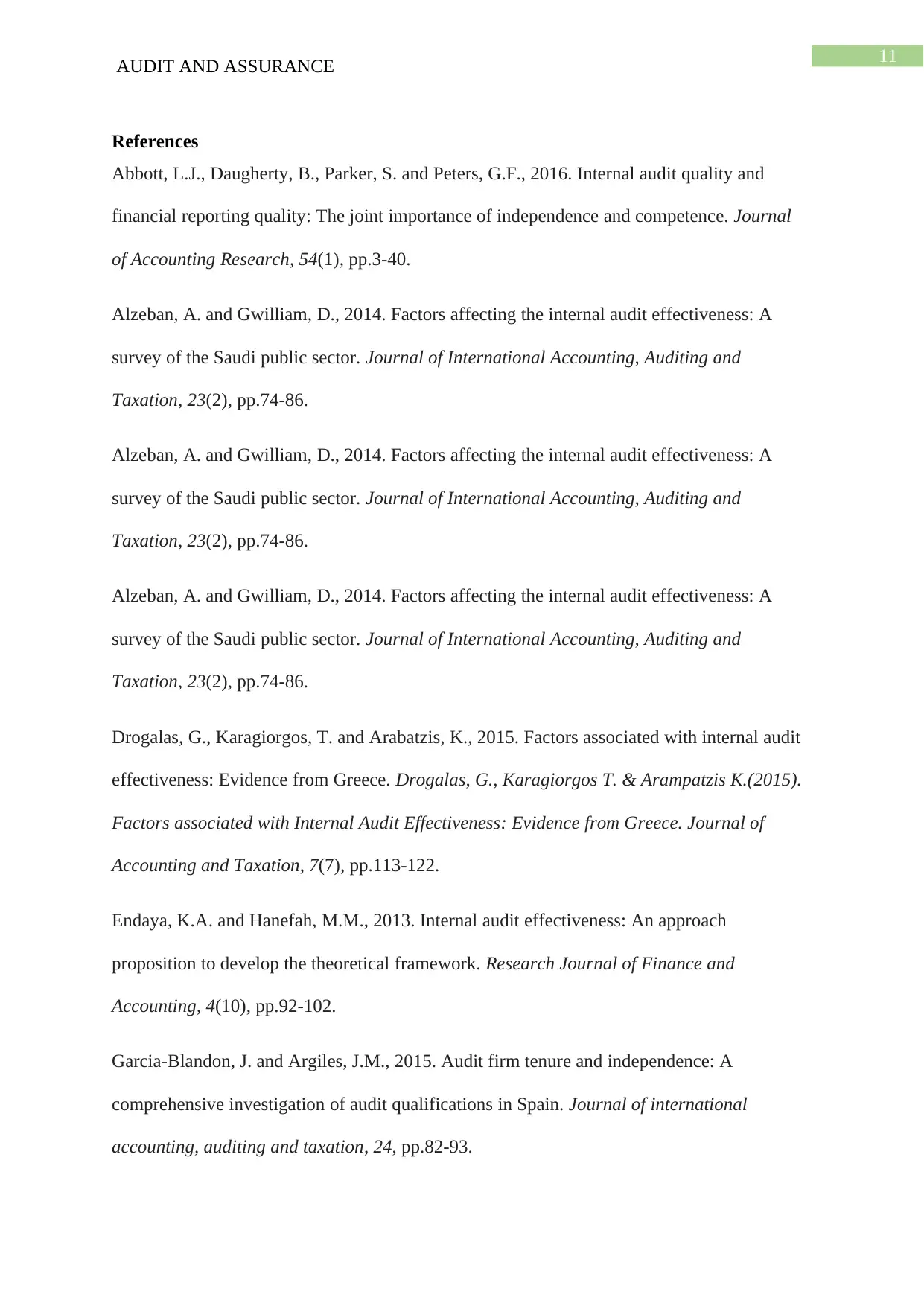
11
AUDIT AND ASSURANCE
References
Abbott, L.J., Daugherty, B., Parker, S. and Peters, G.F., 2016. Internal audit quality and
financial reporting quality: The joint importance of independence and competence. Journal
of Accounting Research, 54(1), pp.3-40.
Alzeban, A. and Gwilliam, D., 2014. Factors affecting the internal audit effectiveness: A
survey of the Saudi public sector. Journal of International Accounting, Auditing and
Taxation, 23(2), pp.74-86.
Alzeban, A. and Gwilliam, D., 2014. Factors affecting the internal audit effectiveness: A
survey of the Saudi public sector. Journal of International Accounting, Auditing and
Taxation, 23(2), pp.74-86.
Alzeban, A. and Gwilliam, D., 2014. Factors affecting the internal audit effectiveness: A
survey of the Saudi public sector. Journal of International Accounting, Auditing and
Taxation, 23(2), pp.74-86.
Drogalas, G., Karagiorgos, T. and Arabatzis, K., 2015. Factors associated with internal audit
effectiveness: Evidence from Greece. Drogalas, G., Karagiorgos T. & Arampatzis K.(2015).
Factors associated with Internal Audit Effectiveness: Evidence from Greece. Journal of
Accounting and Taxation, 7(7), pp.113-122.
Endaya, K.A. and Hanefah, M.M., 2013. Internal audit effectiveness: An approach
proposition to develop the theoretical framework. Research Journal of Finance and
Accounting, 4(10), pp.92-102.
Garcia-Blandon, J. and Argiles, J.M., 2015. Audit firm tenure and independence: A
comprehensive investigation of audit qualifications in Spain. Journal of international
accounting, auditing and taxation, 24, pp.82-93.
AUDIT AND ASSURANCE
References
Abbott, L.J., Daugherty, B., Parker, S. and Peters, G.F., 2016. Internal audit quality and
financial reporting quality: The joint importance of independence and competence. Journal
of Accounting Research, 54(1), pp.3-40.
Alzeban, A. and Gwilliam, D., 2014. Factors affecting the internal audit effectiveness: A
survey of the Saudi public sector. Journal of International Accounting, Auditing and
Taxation, 23(2), pp.74-86.
Alzeban, A. and Gwilliam, D., 2014. Factors affecting the internal audit effectiveness: A
survey of the Saudi public sector. Journal of International Accounting, Auditing and
Taxation, 23(2), pp.74-86.
Alzeban, A. and Gwilliam, D., 2014. Factors affecting the internal audit effectiveness: A
survey of the Saudi public sector. Journal of International Accounting, Auditing and
Taxation, 23(2), pp.74-86.
Drogalas, G., Karagiorgos, T. and Arabatzis, K., 2015. Factors associated with internal audit
effectiveness: Evidence from Greece. Drogalas, G., Karagiorgos T. & Arampatzis K.(2015).
Factors associated with Internal Audit Effectiveness: Evidence from Greece. Journal of
Accounting and Taxation, 7(7), pp.113-122.
Endaya, K.A. and Hanefah, M.M., 2013. Internal audit effectiveness: An approach
proposition to develop the theoretical framework. Research Journal of Finance and
Accounting, 4(10), pp.92-102.
Garcia-Blandon, J. and Argiles, J.M., 2015. Audit firm tenure and independence: A
comprehensive investigation of audit qualifications in Spain. Journal of international
accounting, auditing and taxation, 24, pp.82-93.
⊘ This is a preview!⊘
Do you want full access?
Subscribe today to unlock all pages.

Trusted by 1+ million students worldwide
1 out of 13
Related Documents
Your All-in-One AI-Powered Toolkit for Academic Success.
+13062052269
info@desklib.com
Available 24*7 on WhatsApp / Email
![[object Object]](/_next/static/media/star-bottom.7253800d.svg)
Unlock your academic potential
Copyright © 2020–2025 A2Z Services. All Rights Reserved. Developed and managed by ZUCOL.





